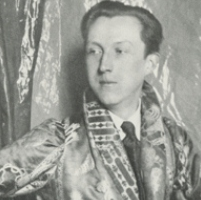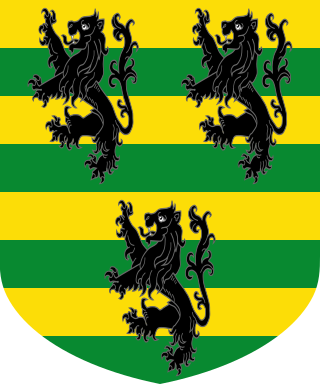
The River Rother, a waterway in the northern midlands of England, gives its name to the town of Rotherham and to the Rother Valley parliamentary constituency. It rises near Clay Cross in Derbyshire and flows in a generally northwards direction through the centre of Chesterfield, where it feeds the Chesterfield Canal, and on through the Rother Valley Country Park and several districts of Sheffield before joining the River Don at Rotherham in Yorkshire. Historically, it powered mills, mainly corn or flour mills, but most had ceased to operate by the early 20th century, and few of the mill buildings survive.

Sir Sacheverell Reresby Sitwell, 6th Baronet, was an English writer, best known as an art critic, music critic, and writer on architecture, particularly the baroque. Dame Edith Sitwell and Sir Osbert Sitwell were his older siblings.

Eckington is a village and civil parish in North East Derbyshire, England. It is 7 miles (11 km) northeast of Chesterfield and 9 miles (14 km) southeast of Sheffield city centre, on the border with South Yorkshire.

Weston Hall is a 17th-century manor house in Weston, Northamptonshire. The house was owned by the Sitwell family's ancestors from 1714 to 2021. It is a Grade II* listed building.

Renishaw is a village in the district of North East Derbyshire in England. It is in the civil parish of Eckington.
The Curious House Guest is a British television documentary series first broadcast on BBC Two in 2005. It is written and presented by Jeremy Musson, an architectural historian and journalist with Country Life. In each episode he visits a historic private house and combines observations on architecture with insights into the lives of the owners.

Melbourne Hall is a Georgian style country house in Melbourne, Derbyshire, previously owned by William Lamb, 2nd Viscount Melbourne, British Prime Minister from 1835 to 1841. The house is now the seat of Lord and Lady Ralph Kerr and is open to the public. The house is a Grade II* listed building; more than twenty features in the grounds are Grade I listed.

Sir George Reresby Sitwell, 4th Baronet was a British antiquarian writer and Conservative politician who sat in the House of Commons between 1885 and 1895.

The Sitwell Baronetcy, of Renishaw in the County of Derby, is a title in the Baronetage of the United Kingdom. It was created on 3 October 1808 for Sitwell Sitwell, Member of Parliament for West Looe. The Sitwell family had been ironmasters and landowners in Eckington, Derbyshire, for many centuries.
Sir Sitwell Sitwell, 1st Baronet was a British politician and landowner.

Ferney Hall is a mid-Victorian-era mansion house situated at Onibury, Shropshire, England. It is a Grade II listed building. The hall is listed Grade II on the National Heritage List for England and its gardens are also Grade II listed on the Register of Historic Parks and Gardens.
Sir Sacheverell Reresby Sitwell, 7th Baronet was the head of the Sitwell family, and owner of Renishaw Hall, Derbyshire.
George Sitwell, the eldest son of George Sitwell (1569–1607) and Mary Walker, was a 17th-century landowner and ironmaster who was born at Eckington in Derbyshire and baptized there on 15 March 1601. He built Renishaw Hall in Derbyshire in 1626. His company mined, forged, and rolled iron for use in Britain and overseas. It exported a complete rolling mill to the West Indies.

Mount Pleasant is an 18th-century mansion situated on Sharrow Lane in the Highfield area of the City of Sheffield in South Yorkshire, England. The house stands just under two km south of the city centre and is a grade II* listed building, it has been described as "one of the best 18th century houses in Sheffield". The adjacent former stables and coach house are also Grade II* listed.
Sir George Reresby Sacheverell Sitwell, 8th Baronet is a British businessman.

Mosborough is a village in the City of Sheffield in South Yorkshire, England. Historically part of Derbyshire, the village was named after The Moss river which flows through the village. During the late 19th century and 20th century, the village was noted for its steelmaking, with Hutton & Co. Sickle works being based at nearby Ridgeway. The village expanded and due to developments in nearby Owlthorpe, Westfields and Waterthorpe. Mosborough which was a township at the time was transferred from Derbyshire to the West Riding of Yorkshire as part of Sheffield.

St Peter and St Paul's Church, Eckington is a Grade I listed parish church in the Church of England in Eckington, Derbyshire.

Litfield Farm is a farm in Ridgeway, Derbyshire. The farm was once regarded as being located in a hamlet east of Ridgeway known as Litfield, but is now part of the larger settlement. The farmhouse is a 17th-century Grade II listed building.
Eckington is a civil parish in the North East Derbyshire district of Derbyshire, England. The parish contains 81 listed buildings that are recorded in the National Heritage List for England. Of these, two are listed at Grade I, the highest of the three grades, two are at Grade II*, the middle grade, and the others are at Grade II, the lowest grade. The parish contains the town of Eckington, the villages of Renishaw, Ridgeway, and Spinkhill, the hamlet of Birley Hay, and the surrounding countryside. The major building in the parish is the country house, Renishaw Hall, which is listed, together with associated structures and items in its grounds. Most of the other listed buildings are houses, cottages and associated structures, farmhouses and farm buildings. The rest of the listed buildings include churches, chapels and associated items, a former Sunday school, a former toll house, a public house, and two bridges.
















